|
|
NOTES ON THE ORIGINS OF GIANT MANTA AND HORN - 4 Written August 2006 |
|
|
NOTES ON THE ORIGINS OF GIANT MANTA AND HORN - 4 Written August 2006 |
NAVIGATION
|
Toku and "the Teddy Curve"
A "TEDDYTOMI" WITH THE GIANT HORN
I'm astonished by some of the resonances I see between these two new giant pipes and the recent "Teddytomis" (a series of pipes carved in 2006 which present conscious, or semi-conscious, improvisations on some of Teddy's lines and forms). Some echoes are apparent at first glance. Others emerge only through close observation of certain underlying forms.
The echoes are especially evident - and surprising - in the more architecturally-shaped 485. |
|
Giant Horn and original "Teddytomi" Conck (461) A certain general relationship between 461 and 485 is clear almost at once, in the curves (curls) described by the shank lines and surfaces (both "inner" and "outer": see diagram below). |


|
The shape of the bowl is also remarkably similar, notwithstanding the simplification of forms in 485. |
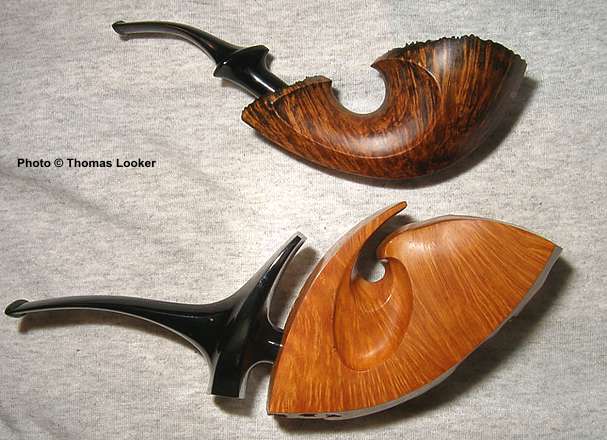
|
In the diagram below, I outline what I see as cross-resonances between the pipes. What's remarkable to me is how Toku has compressed the Teddytomi's bowl-to-shank curve and then reoriented it in his carving of the horn. I can envision that this "imaginative shuffling" may not have been done consciously (yet perhaps it was!)... but it's another wonderful example of Toku's improvisatory abilities. |
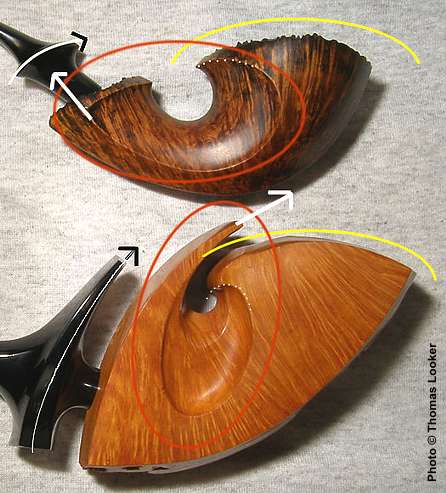
|
Note that the white line (and black arrow-head) above suggests one of the possible imaginative roots of the oversized ebonite ferrule in 485. I don't mean to press this point too hard, but the sweep of the Teddytomi's ebonite ferrule echoes the curve of the shank-end which itself bears the same relationship to the bowl's rim as does the shank-end (and ebonite ferrule) on the horn - that is to say, shank and bowl rim describe a continuous arc. |
|
Teddytomi
Reverse-Sitter (SPC 478) Since the original Teddytomi seemed connected in certain ways to 485, I expected I might find similar resonances in the reverse Teddytomi-sitter (478) as well. At first glance, the pipes do not seem all that close to each other, especially when viewed in a slightly-overhead perspective. |

|
But wait a minute! Lower your point of view and look at the way the curls are constructed in each pipe ... |

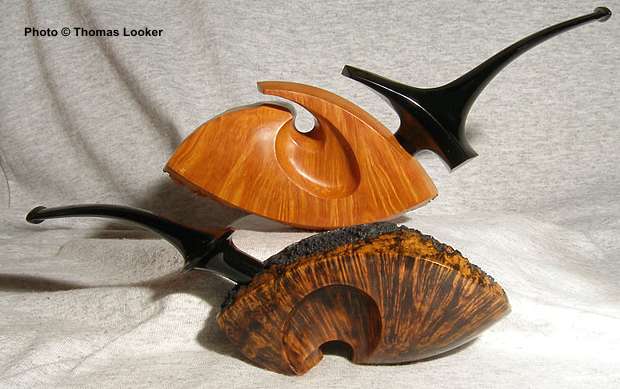
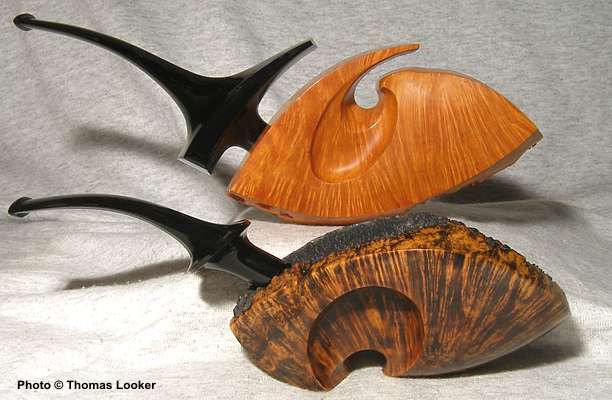
|
And now, take a closer look at other relationships between the lines in each pipe ... Are you beginning to see more connections? |
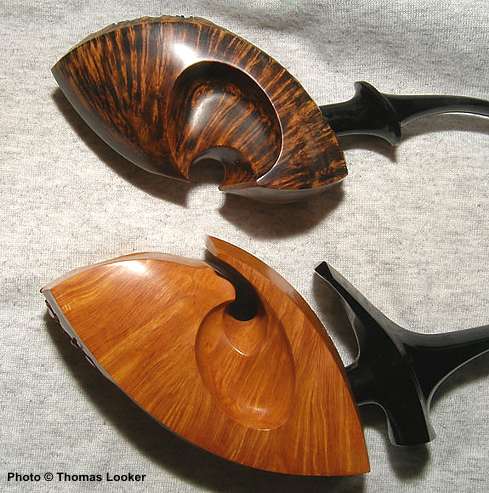
|
What about this viewpoint: |

|
Apotheosis If you've seen it already, the following pictures won't surprise you ... but I must say I fell off my chair when I first realized what Toku had done: |
|
|
|
Yep: in certain respects, this horn is a double-reverse Teddytomi! Also, I think I see in 478 a reinforcement for the idea of an extended tail and the echoing, oversized ferrule. When viewed right-side up, the top line of the reverse Teddytomi seems to anticipate the underlying structure of the horn. So does the way the stem enters the shank: |

|
So my astonishment at Toku's accomplishment in 485 includes the extraordinarily flexible way his imagination has used 478. He was simultaneously able to view it upside-down and right-side up ... and create a pipe that, in a way, seems almost "four dimensional" (It's both itself and the reverse of itself ... I'll bet there's an easier way to say that in Japanese!) Sykes and Todd have both discussed Toku's unique ability to imagine wood in three dimensions as he works at his shaping wheel. Here's another amazing example of what results. |
NAVIGATION
END OF GIANT MANTA AND HORN 4